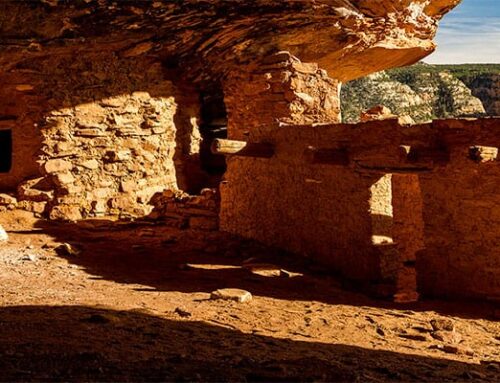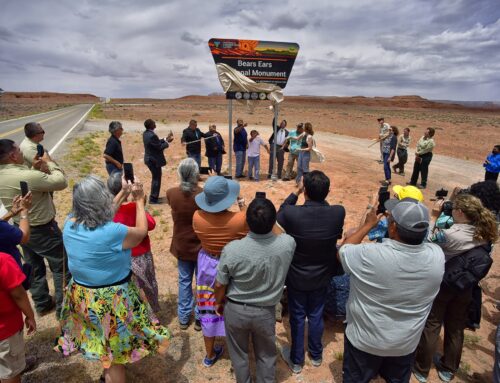Public Release of Monument’s Management Plan Underway as Utah Governor’s Consistency Review Begins
BEARS EARS NATIONAL MONUMENT – Oct. 3, 2024 – The Bears Ears National Monument (BENM) has entered a significant phase in the National Environmental Policy Act (NEPA) process. After years of collaborative work between the five Tribal Nations of the Bears Ears Commission (BEC), the Bureau of Land Management (BLM), the U.S. Forest Service (USFS), and public stakeholders, the Proposed Resource Management Plan and Final Environmental Impact Statement is now available for the public to read.
“Bears Ears is more than just a landscape—it’s a living testament to our ancestors, where their presence is felt, spiritual energy and ceremonies continue. As stewards of this sacred place, it is our duty to protect it, not just for today, but for future generations,” said Curtis Yanito, Navajo Nation Council Delegate and Co-Chair of the Bears Ears Commission. “We are committed to working closely with our federal partners but let there be no mistake—Traditional Knowledge must be at the forefront of managing Bears Ears. This sacred land, its buttes, and the life within it deserve nothing less than respect, reverence, and guidance by the wisdom of the Indigenous peoples who have cared for and blessed it for centuries.”
This milestone marks the beginning of the final stages of the NEPA process. The completed plan will now proceed to the consistency review, during which the Governor of Utah and his staff will review it in relation to state and local transportation plans, zoning ordinances, and other county, state, and local regulations. They will provide feedback to the federal agencies regarding any potential inconsistencies in the proposed final Resource Management Plan. After receiving this feedback, the agencies will decide whether to address any critical inconsistencies before publishing the final plan.
The NEPA process for Bears Ears has included a comprehensive and inclusive Tribal effort to create a resource management plan that balances conservation, cultural preservation, and respectful recreation. The Bears Ears Commission–– composed of elected Tribal leaders from the Hopi Tribe, Navajo Nation, Ute Mountain Ute Tribe, Zuni Tribe, and Ute Indian Tribe–– has played a necessary and crucial role in ensuring that Traditional Ecological and Indigenous Knowledge is woven into the management of the Monument’s landscape and resources.
“Bears Ears is our ancestral home, where the history of our people is etched in stone, sung in our songs, and lives in the very soil beneath us,” said Anthony Sanchez Jr., Head Councilman for the Zuni Tribe and Co-Chair of the Bears Ears Commission. “This landscape defines who we are, and it’s our sacred duty to protect it for generations to come. We urge our federal partners and all stakeholders to ensure that Indigenous Knowledge leads the way in the management of this sacred place. Only by honoring our knowledge, contributions, and traditions can we give Bears Ears the respect it truly deserves.”
The monument’s establishment at the request of the Tribes marked a historic and innovative step in public lands management, recognizing the overdue value of integrating Traditional Knowledge into federal stewardship practices. The Presidential Proclamation also formally recognized the Tribes, through the Bears Ears Commission, as collaborative management partners, ensuring Indigenous leadership plays a vital role in safeguarding and shaping the future of this sacred landscape—an unprecedented development in the history of U.S. public lands management.
Key milestones in the NEPA process so far include:
- Public Scoping: Engaging communities, Tribes, local governments, and stakeholders to gather input on managing the Monument.
- Draft Environmental Impact Statement (DEIS): Released for public comment earlier this year, this document outlines proposed plans and alternatives for managing the land’s ecological, cultural, and recreational resources.
- Public Comment Period: The 90-day public comment period garnered nearly 21,000 comments, most supporting collaborative management and Indigenous-led conservation efforts.
What’s Next?
Following the Governor’s review, the plan will return to the BLM and the USFS, for finalization. Once this process is complete, the management plan will be finalized and published as part of a Record of Decision by the agencies. The final plan will guide the future of Bears Ears for many years, ensuring its cultural and ecological significance is preserved for generations to come, for all.
About the Bears Ears Commission
The Bears Ears Commission represents five Tribal Nations—Ute Indian Tribe, Ute Mountain Ute Tribe, Zuni Tribe, The Hopi Tribe and the Navajo Nation—who work collaboratively with the U.S. Bureau of Land Management and U.S. Forest Service to manage and steward the Bears Ears National Monument. The Commission represents the first time in U.S. history that a coalition of Tribal Nations has collaborated with federal agencies to craft a management plan for a national monument. The Commission was established during the Obama administration, following the President’s proclamation that established Bears Ears as a National Monument.
About the Bears Ears Inter-Tribal Coalition (BEITC): The BEITC is a fiscally sponsored project of the Resources Legacy Fund, a 501(c)(3) nonprofit organization, which relies on charitable giving to support the Bears Ears Commission in fulfilling its collaborative management responsibilities. Follow the Coalition on Instagram, Facebook, LinkedIn, and X.
Contact:
Ruben Pacheco
Director of Communications and Partnerships
Bears Ears Inter-Tribal Coalition
RPacheco@BearsEarsCoalition.Org



